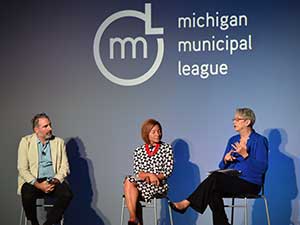
Brian Boyle, Renee Johnston, Marilyn Schlack
Everyone has an important role to play in reinvigorating their community – from residents and local government officials to the wide variety of community anchor organizations. To tackle this topic, we brought in Brian Boyle, co-chief executive officer of Issue Media Group, to quiz some community leaders on the unique ways they’ve been improving the quality of life in their community and enhancing talent attraction: Renee Johnston, president and CEO of Saginaw Community Foundation, and Marilyn Schlack, president of Kalamazoo Valley Community College.
Johnston shared that the Saginaw Community Foundation is part of a diverse group of individuals from across the county that was established to develop partnerships and be prepared to deal with any community emergencies that might arise. They established several key ares on which to focus their efforts: transportation, ex-offender friendly employers, healthcare, and education. Johnston says that because they get together on a regular basis, it has been easier to get things done. They’re truly seeing the needle move because they’re putting that collaboration together.
One example involved the opportunity to get a health-related grant. Johnston says it was easy to figure out what project to work on because she know who to call. Everyone agreed on one area – obesity – because it could impact so many.
For Schlack, much of Kalamazoo Community College’s recent community partnering has revolved around the Healthy Living Campus, which has a multi-disciplinary approach to culinary, agricultural, and health programs. The campus is a collaboration between KVCC, Bronson Hospital, the city of Kalamazoo, and others. All the partners are working toward the goal of rebuilding trhe local food system so it will support the local economy, provide good jobs, help the underserved better understand how food affects them mentally and physically, and give college students a firm understanding of what it means to be a sustainable community.
Q&A Session
Moderator Brian Boyle posed several questions to Renee Johnston and Marilyn Schlack.
Q. How do you get from conversation to action?
Schlack: We invited the community to join us in developing the vision for the Healthy Living Campus, particularly a diverse group of residents. We went to Detroit to see what they’re doing with local food and came back committed to doing it faster and in a ways that would be inclusive with those who are already at the table. In less than three years, we had a new campus.
Q. Who are going to be your community partners?
Johnston: We opened the door to everyone. There might have been five groups working on the same thing, and we brought them together. Groups who don’t want to work together eventually remove themselves.
Schlack: Our bigger challenge is inviting those who feel disenfranchised. That was one of our big goals with the Healthy Living Campus. We want them to feel like it belongs to them, too, and that we’re all in this together.
Q. Have you experienced any failures in community engagement, and what have you learned?
Schlack: We had lots of focus groups with residents, businesses, etc. What I find is that people often say something won’t work, but then it starts working and everyone takes credit. If that’s what it takes, I’m OK with that. Set your goals and move forward.
Johnston: In our public safety program, a partner volunteered to spearhead the collaborative effort. Unfortunately, he caused more animosity than partnership. He eventually dismissed himself and the program became successful.
Q. Is there a problem with people taking credit?
Schack: There are naysayers, but Kalamazoo is a very generous and supportive community. You have to keep your eye on what you’re trying to achieve and keep moving forward.
Johnston: Fifteen years ago it was a problem. But we’ve gotten to the point where key groups collaborate together and look at themselves as a group.
Q. What type of benchmarks or metrics do you use?
Johnston: For one of our first successes, we identified areas where we wanted to be transparent with the community. We reach out to Saginaw Valley State University to create a report card of our work that’s available to the public. That has been well received.
Schlack: We have a community report card on all the Healthy Living Campus topics. We gave people assignments to track certain areas, laid out objectives, check to see what’s working or now, and make adjustments.
Q. How does design and creativity integrate into your work?
Schlack: We brought in an outside architect to make sure the buildings were attractive and historic buildings were respected. Some Kalamazoo philanthropies are donating $70 million to the city and we’re all working on figuring out how to make this money work most effectively.
Johnston: We bring the right parties together to figure out the best design for a park or a building. We have a committee that focuses on city and county parks and how their designs can work together, connect trails, etc.
Q. How do you balance community excitement with realistic expectations?
Johnston: We focus on what are the deliverables? What is the time line? What are the goals? We try to give ourselves time to figure this out and come up with a realistic timeline. You don’t want people to lose momentum.

